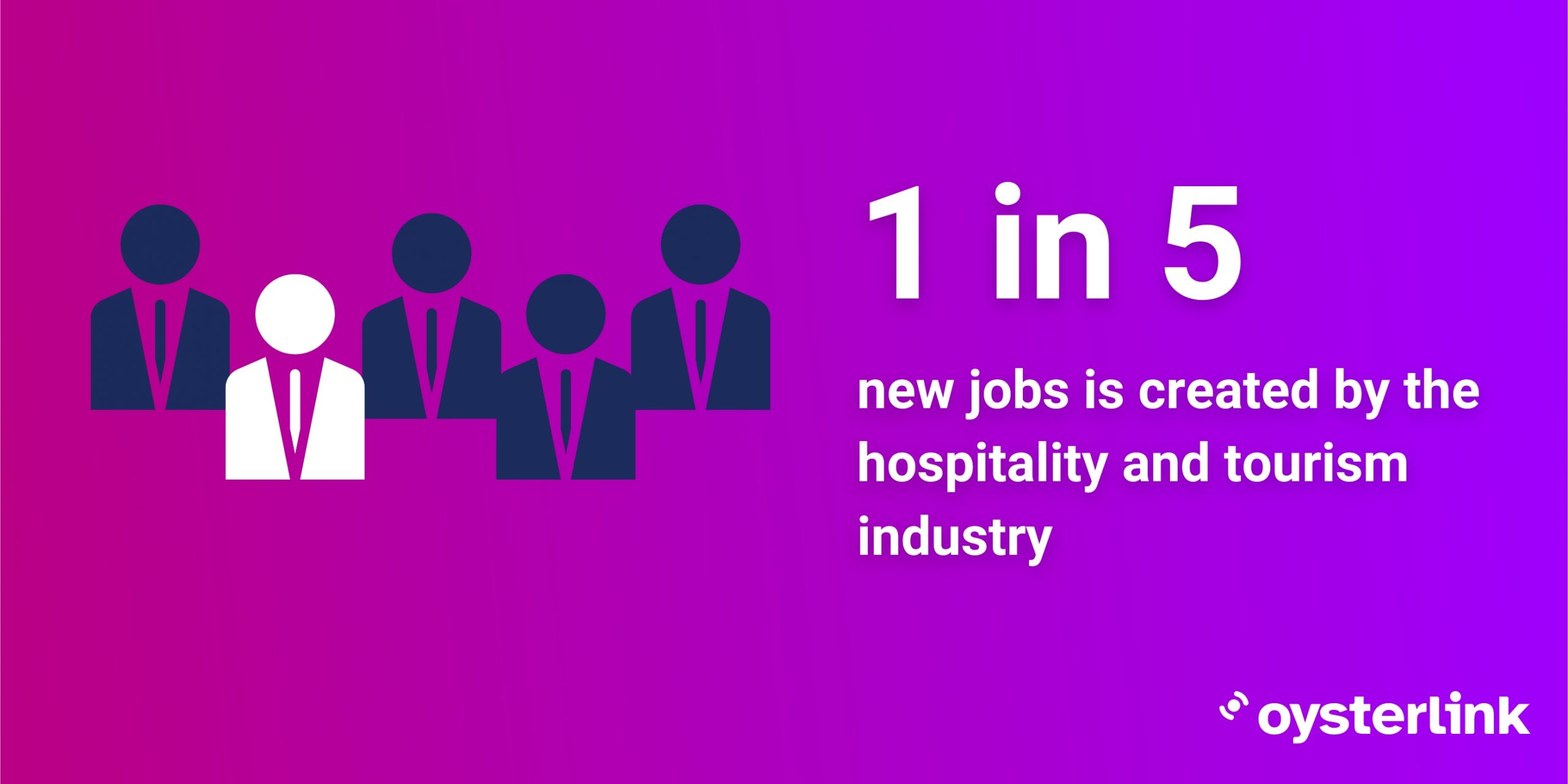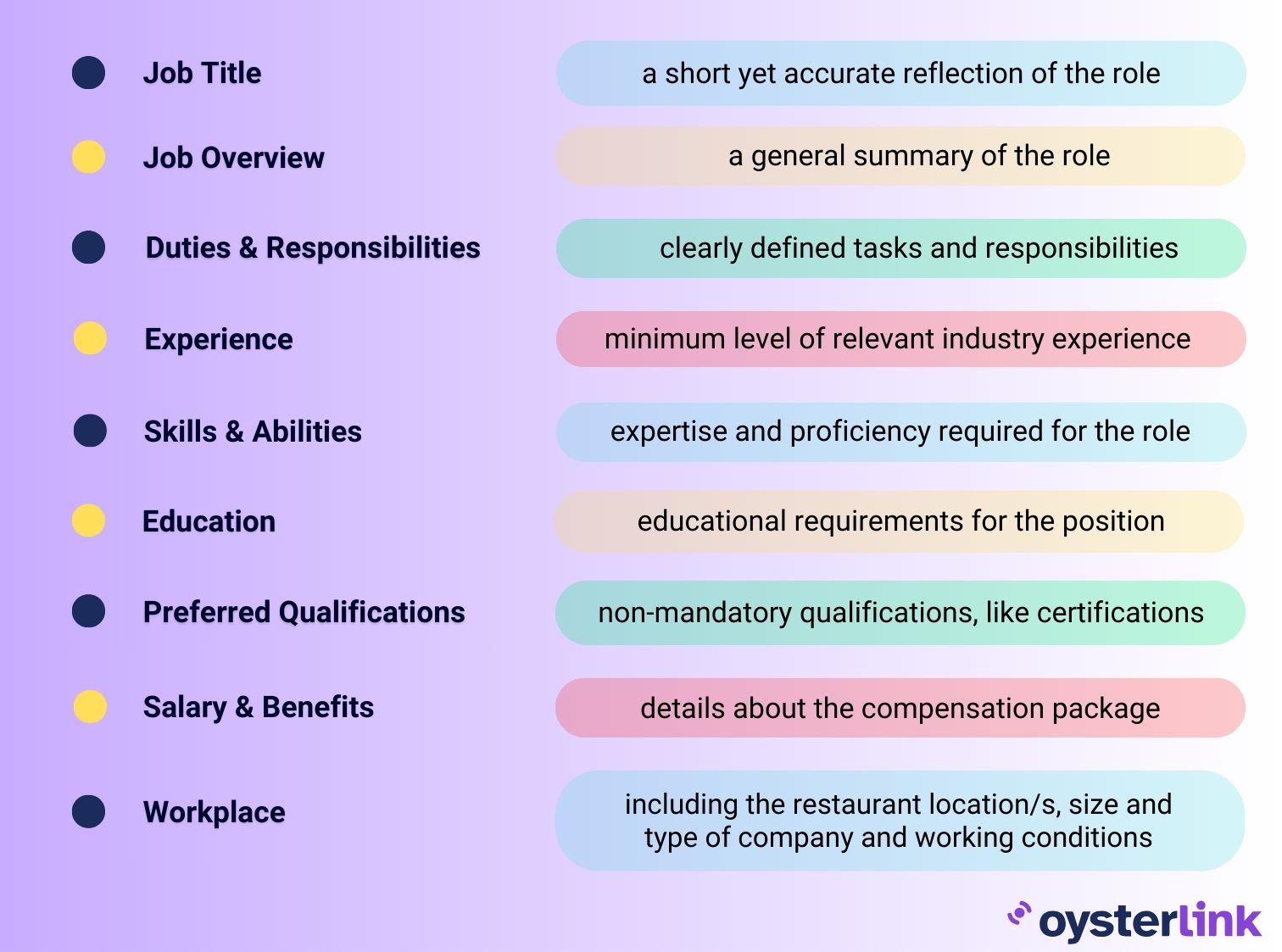The World Travel & Tourism Council (WTTC) states that 1 in 5 new jobs is created by the hospitality and tourism industry.

Given this intense competition in talent sourcing, employers must exert every effort to ensure they attract the best talent.
This guide will explain the process of writing an effective job description for Chefs — what to include, practices that should be omitted, such as abbreviations, as well as certifications you’d want your potential candidates to have.
Chef Job Description Template
Below is a customizable job description template you can use to share the requirements and expectations for your Chef job advertisement.
Chef Job Overview
Join our culinary team at [Company Name], where your role as a Chef is indispensable to the seamless operation of our establishment.
You’ll work closely with our culinary management team to ensure excellent culinary standards and improve the overall dining experience for our customers.
Your responsibilities will span from overseeing kitchen operations to ensuring the smooth execution of culinary events and special occasions.
Mastery of culinary administration, encompassing inventory management and financial oversight, is important for succeeding in this position.
If you’re ready to advance your culinary career in an environment that values dedication and ambition, [Company Name] is an ideal environment for your professional growth.
Salary: $20–$30/hour (non-tipped position)
Schedule: Full-Time (40 hours per week), Monday–Friday, with the possibility of overtime beyond 40 hours per week
Chef Duties & Responsibilities
- Plan and create menus, considering factors such as seasonal availability, cost and customer preferences
- Oversee daily kitchen operations, ensuring efficiency and following quality standards
- Manage kitchen staff, including Cooks, Sous Chefs and other culinary team members
- Supervise food preparation and cooking processes, ensuring consistency and high-quality outcomes
- Monitor inventory levels of food and place orders as needed
- Enforce health and safety standards in the kitchen, including proper food handling and sanitation
- Develop and standardize recipes and train kitchen staff on proper preparation techniques
- Stay updated on industry trends and innovations to keep the menu fresh and appealing
- Troubleshoot and resolve kitchen-related issues to ensure smooth daily operations
- Maintain a clean and organized kitchen environment, adhering to sanitation guidelines
- Collaborate with restaurant management to create a positive and cohesive working environment
Chef Experience Requirements & Skills
- Knowledge of various cooking techniques and cuisines
- Familiarity with food safety and sanitation regulations
- Culinary creativity and the ability to develop new recipes
- Strong leadership and management skills for overseeing kitchen staff
- Excellent communication skills to effectively coordinate with the kitchen team
- Time management and organizational skills
- Attention to detail in food preparation and presentation
- Ability to work under pressure and meet deadlines
Chef Education & Qualifications
- Culinary degree from a recognized culinary school or institute
- Formal apprenticeship or on-the-job training in a professional kitchen
- Relevant certifications in food safety and sanitation
- Proven experience working in a kitchen or culinary environment
How To Write a Job Description
A job description serves as the first point of contact between employers and potential candidates.
Therefore, it must be written effectively to entice qualified candidates and facilitate informed decisions from both parties. Below are some practical tips for writing job descriptions.
- Strive for clarity in your language: Use simple sentences and concise wording to avoid confusing prospective applicants. As an employer, it’s crucial to effectively communicate the duties and requirements of the position to ensure understanding and alignment with potential candidates.
- Keep a positive tone: Use a positive and welcoming tone in your job description. This doesn’t mean you have to break professionalism, it’s all about striking the balance between being friendly and courteous to help candidates feel valued and excited about the chance to be a part of your team.
- Provide a detailed list of duties: Be specific about the daily tasks and responsibilities. Don’t use vague language when outlining a Chef’s role to help candidates understand what’s expected of them and for them to assess if they’re the right fit for the position.
- Structure your job description in a clean and organized format: Optimize the formatting of your job description so that it’s easy to read and navigate. Break up large blocks of text using bullet points and subheadings. Ensure that your job description is appealing and accessible across different devices.
- Spell out terms before resorting to abbreviations and acronyms: While abbreviations and acronyms help in keeping your job description concise, some candidates may not grasp their meaning. It’s advisable to spell out the complete word or phrase initially before introducing the corresponding abbreviation or acronym later on.
- Encourage inclusivity through gender-neutral language: Using gender-neutral language in the job description promotes inclusivity and diversity. It guarantees that all candidates, regardless of gender, perceive equal representation and appreciation.
- Highlight perks and company culture: List the benefits and perks of working as a Chef in your restaurant or hotel, as well as the unique aspects of your company’s culture. This will set you apart from other competitors and make candidates excited to join your team.
Read our comprehensive guide on How To Write a Job Description.
What To Include in Your Chef Job Description
An effective job description for Chefs includes these eight sections.

Job Title
The job title must precisely reflect the duties of the position. It should be concise and descriptive, providing candidates with a clear understanding of the associated responsibilities expected.
In this case, the job title would be “Chef.”
Job Purpose
This section offers an overview of the role, emphasizing its purpose and mission within the company or organization.
For a Chef, the job purpose should outline the role’s objective in the restaurant or hotel.
For example: This position aims to lead the kitchen team in creating high-quality menus and delivering excellent dining experiences to guests. The Chef plays an important role in upholding the company’s reputation for exceptional culinary standards.
Job Duties and Responsibilities
This section should provide specific details regarding the duties and responsibilities inherent to the role. Each responsibility should be clearly written to help candidates have a good understanding of their expected tasks.
For Chefs, these responsibilities may include tasks such as menu planning, recipe development, overseeing kitchen operations, managing inventory, ensuring food safety standards and leading the kitchen staff.
Education
Outline the educational requirements for the role. This can include degrees, certifications or training courses that help Chefs perform their duties better or ensure the health of the establishment’s customers.
For Chefs, while a high school diploma or GED is generally acceptable, having certifications or a degree can be advantageous.
Experience
This section outlines the minimum level of professional experience necessary for the role.
For a Chef, candidates might be expected to possess prior experience in culinary environments.
Skills and Abilities
Enumerate specific skills and abilities essential for success in the role.
This can include expertise in different culinary techniques, proficiency in menu planning, knowledge of food safety regulations and strong leadership and management skills.
Preferred Qualifications
This section emphasizes any extra qualifications or characteristics that are nice to have but not required for the role.
This can include advanced culinary certifications, experience with specific cuisines and knowledge of wine pairings.
Working Conditions
This part clearly describes the environment the candidate can potentially work in.
For a Chef this is usually exposure to hot temperatures, standing for prolonged periods and loud noise levels.
Step-by-Step Guide to Writing a Chef Job Description
To make writing job descriptions for Chefs easier, follow this guide below.
Chef | [Restaurant Name]
Company: [Name of Restaurant or Hotel]
Location: [City, State]
About [Restaurant Name] Provide a brief description of your hotel or restaurant. Mention your company values, mission statement and unique offerings.
Chef Job Overview Provide a summary detailing the Chef’s role in your establishment, including primary duties, essential skills and qualifications to be successful in the position. This section should also include the salary and whether you’re offering a part-time or full-time position.
Salary: [$/year/hour]
Schedule: [part-time, full-time and/or on-call]
Duties and Responsibilities
List the duties and responsibilities expected of a Chef in your establishment.
Experience Requirements and Skills
Outline the minimum culinary industry experience and required skills for potential candidates. Specify if previous supervisory or managerial experience is necessary.
Education and Qualifications
Specify your requirements and preferences for the educational background, on-the-job training, certifications and qualifications for the position.
Contact Information Provide essential contact details for candidates to inquire or submit applications.
Contact Person:
Contact Email Address:
Contact Phone Number:
Chef Certifications
Certifications validate a Chef’s skills and expertise and show their commitment to continuous learning.
Below is a list of certifications you may want to consider including in your job description.
| Certification | Organization | Description |
|---|---|---|
| Certified Executive Chef | American Culinary Foundation | Tailored for experienced industry professionals, showcasing advanced culinary expertise and leadership capabilities |
| Certified Culinarian | American Culinary Foundation | Ideal for those just starting in the industry; provides an overview of fundamental culinary techniques |
| Certified Sous Chef | American Culinary Foundation | Created for experienced Sous Chefs looking to advance their careers in kitchen management |
| ServSafe Food Protection Manager Certification | National Restaurant Association | Covers advanced topics regarding food safety management |
| Certified Specialist of Wine | Society of Wine Educators | Valuable for those working in upscale establishments; helps Chefs elevate their dishes through wine pairing |
Chef Salary
According to the Bureau of Labor Statistics (BLS), the average base salary for a Chef in the United States is $62,640 per year or $30.12 per hour.
Chef Salary Across the US
To assist you in determining a salary for your job posting, here’s a summary of Chef salaries across the United States.
[Source: BLS]
This map is interactive. Hover your mouse over different parts of the map to see detailed data.
Similar Job Titles
Chef Job Description FAQ
The level of experience required varies depending on the requirements of the establishment. Generally, candidates for Chef positions are expected to have a minimum of two to three years of experience working in a professional kitchen.
However, some establishments may require longer years of experience based on the demands of the operations.
Hiring the right Chef for your establishment begins with crafting an effective job description. Clearly outlining the skills and qualifications your business requires enables you to efficiently filter and sort through candidates, ensuring that you don’t waste time and hire someone capable of fulfilling the role.
The next step is conducting comprehensive interviews to evaluate the skills mentioned in the candidate’s application. This provides you with an opportunity to assess the candidate’s compatibility with your company’s culture.
If you’re seeking additional resources to assist you in preparing for the interview, OysterLink offers a guide on conducting interviews and provides suggestions for interview questions to ask prospective employees.
The difference between the two lies in their target audience: the Food Handler license is specifically designed for those who directly serve food to customers, such as Bartenders, Waiters and Servers, while the Food Protection Manager certification is primarily intended for those who oversee food preparation.
Both the Food Handler license and Food Protection Manager certification are offered by the National Restaurant Association to educate culinary professionals on proper food safety management, prevent foodborne diseases and safeguard the health of customers.